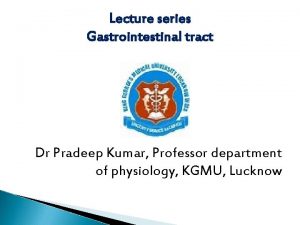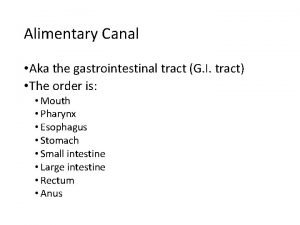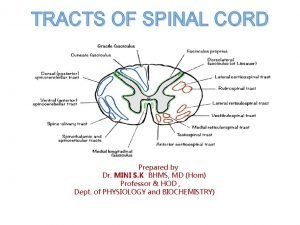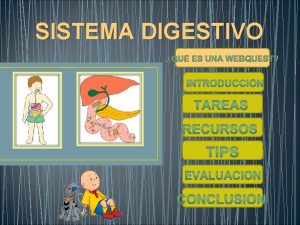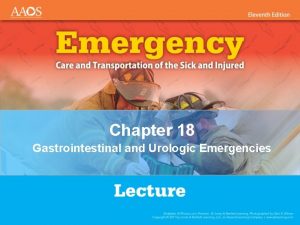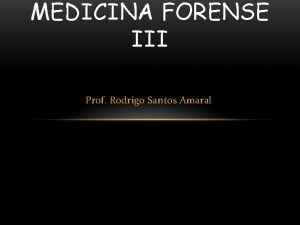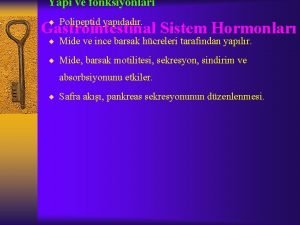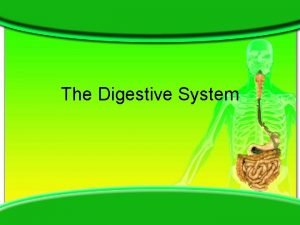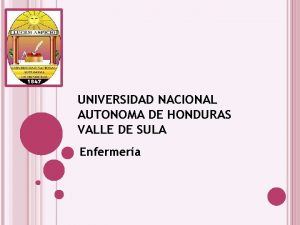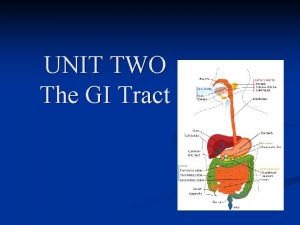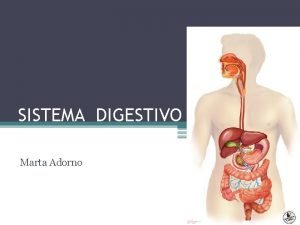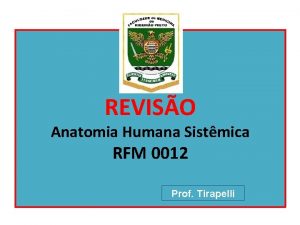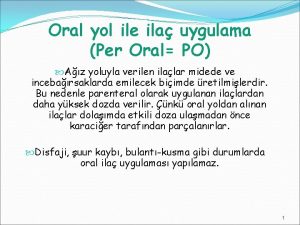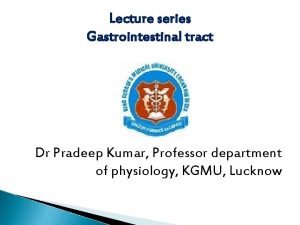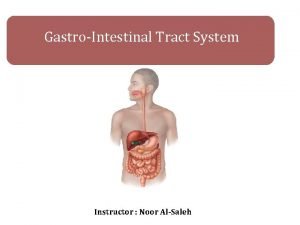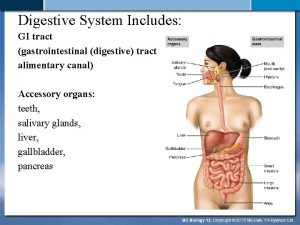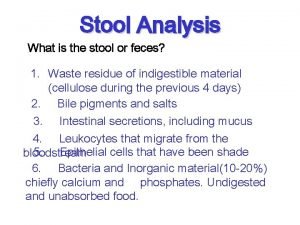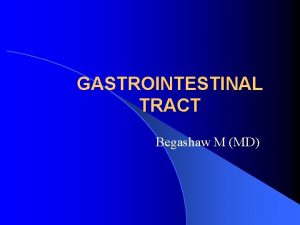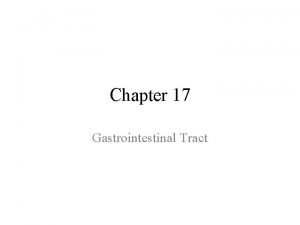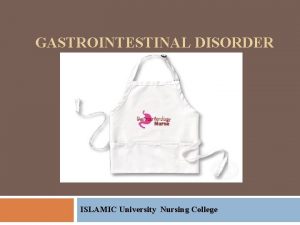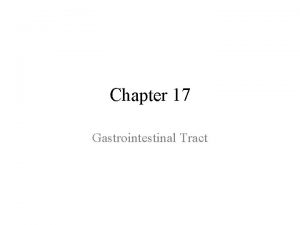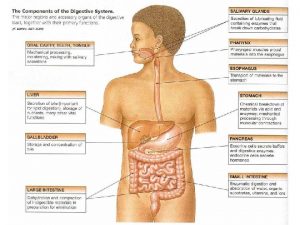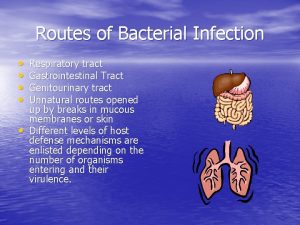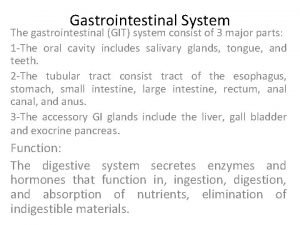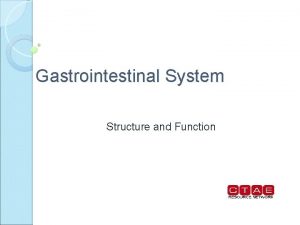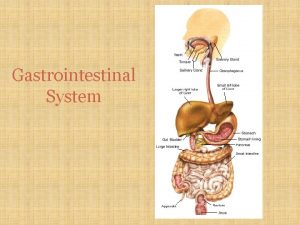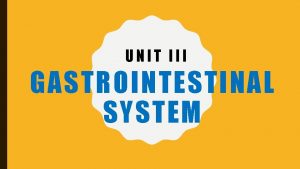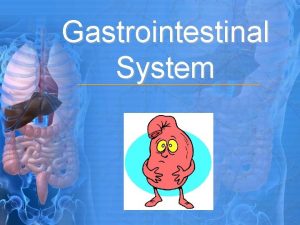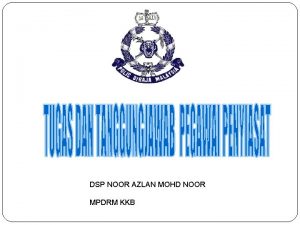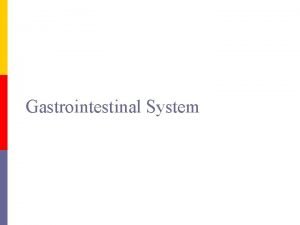GastroIntestinal Tract System Instructor Noor AlSaleh Introduction Stool






















- Slides: 22

Gastro-Intestinal Tract System Instructor : Noor Al-Saleh

Introduction Stool Examination for GIT infections: 1) Stool culture, to identify Bacteria 2) Fecal wet mount, to identify Parasites

Stool Examination 1 - Stool culture (S-S) Agar: is a selective and differential medium for the isolation, cultivation and differentiation of Salmonella spp. and Shigella spp. Salmonella spp on s-s agar Colonies with black heads (H 2 S producer) Shigella spp on s-s agar

Stool Examination 2 -Fecal wet mount preparation: GI infections by parasites are primarily diagnosed by: 1 - Cysts 4 - Helminth eggs 2 - Trophozites 5 - Helminth larva 3 - Oocysts 6 - Occasionally adults worms/segments Ø Saline wet mount: -demonstrates: eggs, larvae, trophozoites, cysts, RBCs and WBCs -detects motility of alive trophozites Ø Lugol’s Iodine wet mount: -stains nuclei and intra-cytoplasmic organelles üOnce Iodine is added, the organism will be killed and motility will be lost

Stool Examination 2 -Fecal wet mount preparation: 1 - Place one drop of saline/Iodine on different slides 2 - Dissolve small amount of stool (size=match head) in each drop, mix 3 - place cover slip (avoid air bubbles) 4 - Examine under 10 X then 40 X objective lens üThe mount should be just thick that newspaper print can be read through the slide

Parasite Identification Ø Intestinal protozoa: (unicellular) - Rhaizopode: Entamoeba histolytica - Flagellate: Giardia lamblia - Ciliates: Balantidium coli

Entamoeba histolytica - Trophozoite ØProgressive and directional motility by pseudopodium Ø Nucleus: 1 N with fine evenly distributed membrane chromatin and small central karyosome Ø Cytoplasm: contains ingested RBCs (erythrophagocytosis) Ø Disease: Amoebic Dysentery Ø Diagnostic stage: Trophozoites or cysts in stool specimen

Entamoeba histolytica - Trophozoite

Entamoeba histolytica - Cyst Ø Round shape Ø non-motile Ø Infective stage Ø Nucleus: 1 N or 2 N or 4 N Ø Cytoplasm: may contains chromatoidal bars and glycogen vacuoles

Giardia lamblia - Trophozoite Ø Pear shaped Ø Falling leaf movement (erratic) Ø Nucleus: 2 N with giant karyosome, no membrane chromatin Ø Sucking disk: for attachment Ø 8 Flagella Ø Axonemes: gives rigidity Ø 2 Median bodies: composed of microtubules

Giardia lamblia - Trophozoite

Giardia lamblia - Cyst Ø Oval shape ØInfective stage Ø Nucleus: 4 N Ø Axonemes present Ø 2 or 4 Median bodies ØDisease: Giardiasis (Traveler’s Diarrhea) Ø Diagnostic stage: Trophozoites or cysts in stool specimen

Balantidium coli - Trophozoite ü The only ciliate to infect humans Ø Oval shape Ø Nucleus: 2 N üMacronucleus (kidney shape) üMicronucleus Ø Cytoplasm: Food and contractile vacuoles Ø Funnel-like cytostome (mouth-like) Ø Covered with cilia

Balantidium coli - Cyst Ø Oval or spherical shape ØInfective stage Ø Macronucleus Ø Thick cyst wall with 1 or 2 layers ØDisease: Balantidiasis Ø Diagnostic stage: Trophozoites or cysts in stool specimen

Parasite Identification Ø Helminthes-Worms: (multicellular) - Cestodes (Flat worms): Tapeworms - Taenia saginata - Nematodes (Round worm): = Ascaris – Acaris lumbricoides = Hook worms - Ancylostoma duodenale / Necator americanus = Pin worm - Enterobius vermicularis = Whip worm - Trichuris trichura

Cestodes - Taenia saginata Disease: Taeniasis Diagnostic stage: A- usually by finding the ova/eggs in stool B- finding the gravid proglottid in stool Ova/egg features: 1 - Sepherical or slightly oval 2 - radially-striated 3 - The internal oncosphere contains 6 refractile hooks (hexacanth emryo)

Cestodes - Taenia saginata Gravid proglottid: very mature segment found posteriorly, contains uterus filled with eggs, occasionally seen in stool

Nematodes - Ascaris lumbricoides -The most common human helminthic infection -Largest intestinal nematode Disease: Ascariasis Diagnostic stage: A- fertilized and unfertilized eggs in stool B- adult worms in stool (rarely) Ova/egg features: 1 -fertilized egg: rounded, thick shell with external mammillated layer 2 - unfertilized egg: oval, thin shell with more variable mammillated layer, larger than the fertilized egg, contains a mass of retractile granules

Nematodes - Ascaris lumbricoides

Nematodes - Hookworms 1 - Ancylostoma duodenale “old world hookworm” Ancylostomiasis 2 - Necator americanus “ new world hookworm” Necatoriasis Diagnostic stage: Finding eggs in stool Ova/egg features: - The eggs of Ancylostoma duodenale and Necator americanus can’t be differentiated microscopically - Eggs are colorless, thin-shelled

Nematodes (Pin worm) - Enterobius vermicularis Disease: Entrobiasis Diagnostic stage: 1 - eggs collected from perianal area by “Scotch test” Eggs not commonly found in stool 2 - adult worms from perianal area or in stool Ova/egg features: “D” shaped, elongated-oval slightly flattened on one side Photo credit: Mohammad Muneer – Passion Batch

Nematodes (Whip worm) - Trichuris trichura Diagnostic stage: Finding unembryonated eggs in stool Ova/egg features: Lemon-shaped, thick-shelled with pair of polar plugs
 Gastrointestinal tract
Gastrointestinal tract Gastrointestinal tract
Gastrointestinal tract Composition of stomach
Composition of stomach Distal organ
Distal organ Extrapyramidal tract function
Extrapyramidal tract function Dorsal reticulospinal tract
Dorsal reticulospinal tract Chapter 15 the gastrointestinal system
Chapter 15 the gastrointestinal system Embriologia del sistema gastrointestinal
Embriologia del sistema gastrointestinal Emt chapter 18 gastrointestinal and urologic emergencies
Emt chapter 18 gastrointestinal and urologic emergencies Gastrointestinal hormones
Gastrointestinal hormones Sigid djuniawan
Sigid djuniawan Sinal de lichtenberg medicina legal
Sinal de lichtenberg medicina legal Gastrik inhibitör polipeptid
Gastrik inhibitör polipeptid Gastrointestinal medical terminology breakdown
Gastrointestinal medical terminology breakdown Nutrition focused physical assessment
Nutrition focused physical assessment Embryo folding
Embryo folding Motilidad gastrointestinal
Motilidad gastrointestinal Gastrointestinal diagram
Gastrointestinal diagram Sistema digestivo
Sistema digestivo Anatomia do rim
Anatomia do rim Conistipation
Conistipation Po ilaç
Po ilaç Intestinal villus
Intestinal villus

